Bike tours are getting trendy these days. Most people are choosing bike tour vacations over other luxury trips for exploring immense adventures.
Regular riders often go on hillbike tours with their teammates. But is it safe for beginners to go on bike tours?
Yes. It’s safe if they train themselves for a long bike tour. It won’t be recommended to plan a bike tour without a perfect training period.
If you’re a newbie in bike riding, you must organize a suitable training plan for a safe bike tour.
So you must be thinking about where to start and what to follow, right?
Don’t worry mate! We’re here with a complete guide to beginner training for a bike tour. Now without further ado, let’s get started.
Importance of Training for a Bike Tour
From beginners to professionals, everyone needs to train themselves before going on a bike tour because it makes the body and mind flexible.
No matter if you’re planning for a one-day short trip or an extended holiday on hills, training is highly important to ensure a comfortable bike tour experience.
- First of all, bike riding influences your physical condition. If you ride for long hours, it can cause pain in muscles, joints, and the cardiovascular system. But training before the tour can save you from leg fatigue, severe injuries, and strains and boost your cardiovascular health.
- You have to prepare your mind for handling the bike in difficult situations such as unfamiliar trails and inconvenient weather conditions. With training, it will be possible for you to go through the challenges efficiently.
- As you’re going on a bike tour for an off-day or holiday, it’s important to enjoy it to the fullest. And it can be possible if you can utilize the time perfectly to estimate the speed and endurance. On the bike tour training, you’ll learn to plan the distance and rest time that helps to cover more places.
- Basic cycling skills won’t be enough for a safe bike tour. That’s why training is mandatory because it improves your skills and makes the bike tour secure.
- When you complete the training session, it will boost your confidence level to the sky. Then you’ll stop fearing accidents and enjoy bike riding more.
What to Consider Before Start Training for a Bike Tour
Along with these benefits, you should consider some necessary things before your bike tour training to make your journey smoother and safer. It also ensures effective bike training.

- Evaluating your fitness level
After learning the basic riding skills, you need to take a fitness assessment.
The best way to assess your fitness for riding is an FTP test because it helps to determine the anaerobic and endurance capacity of riders with a power meter.
This test will also help you to understand your interval sets and power zones for planning the training sessions.
- Selecting the perfect bike for the tour
While choosing the touring bike, you should consider the frame design and material. For better stability, take the bike with a long wheelbase and chainstays.
Most of the touring bike frames are made of chromoly steel that guarantees durability and also ensures flexibility on uneven roads.
Furthermore, look into the wheel size, it should be 26 inches for perfect grip and bump absorption capacity.
When it comes to tires, a touring bike should have a 35 mm tire with puncture resistance capacity and little thread.
There are various brake types in bikes and the hydraulic disk brakes are the most reliable one for touring bikes.
Finally, consider the budget and get the one that includes all these features.
- Creating a realistic goal and training plan
To ensure a successful training plan, you should make realistic targets that you can achieve. Otherwise, it can be challenging for you to be consistent with the training sessions.
For instance, a 12-week plan can be enough to train you for a bike tour.
But if you want to train yourself in a day or overnight, it’s quite impossible.
It also depends on the rider’s fitness, cycling skills, and dedication.
- Including necessary gear and equipment
While starting your training sessions, you will need some gear and equipment to make it better.
Apart from your best touring bike, take reflective clothes, high-quality helmets, water bottles, footwear, useful multitools on roads, the best bike locks for bike safety, power meters, GPS navigators, and gloves based on weather.
Most touring bikes come with rear & front lights, fenders, baskets, and saddlebags.
But if your bike doesn’t include these accessories, install them separately for comfortable training sessions.
How to Train Your Body and Mind for a Bike Tour?
Bike tour training can be difficult for you if your body and mind aren’t strong enough to take on all the challenges.
These techniques will help you to make the body and mind ready for the training plan.
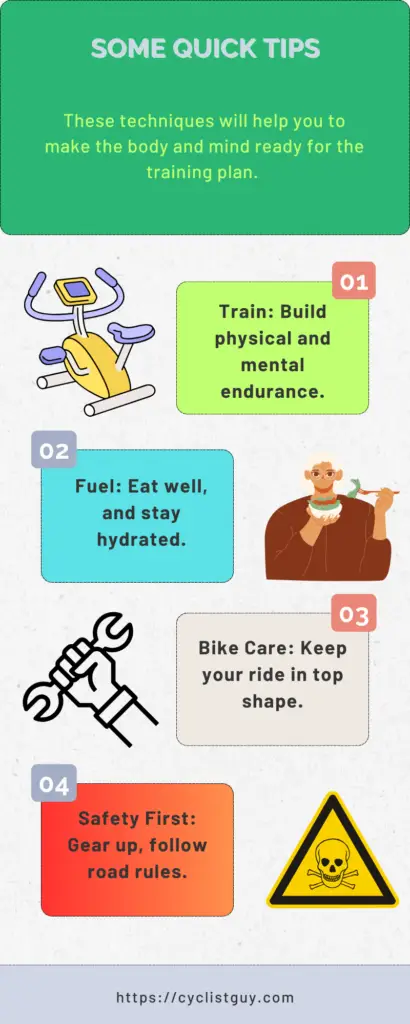
- Setting up a workout routine
Before the training, it’s important to exercise for flexibility. To make your cardiovascular health better, you can try brisk walking, swimming, and jogging.
However, you can add squats, leg presses, planks, Russian twists, and lunges for a strong upper body and legs.
Also, include regular stretches, yoga, light indoor cycling, or foam rolling exercises for high flexibility.
Make a workout routine and schedule these exercises according to your physical condition.
- Boosting your endurance
Regular workouts won’t be sufficient to build endurance for a bike tour.
So, you need to make your plan with interval training, hill training, and cross-training to boost your tolerance level.
In addition to these, you should take slow rides on your bike sometimes and increase the speed gradually.
- Preparing better nutrition and hydration
Proper nutrition and hydration are highly mandatory for pre-training and during the training period.
We recommend drinking 500 to 600 ml water for at least 2 to 3 hours on pre-training, and 200 to 300 ml water every 15 to 20 minutes during training.
In the post-training period, drink at least 600 to 700 ml water or electrolyte fluids.
For nutrition, you should include carbohydrates, and protein in your daily meal plan on pre-training and during training.
Also, create a balanced diet plan, control the portions, and maintain consistent timing.
- Developing a positive mindset and mental flexibility
Not only physical fitness, but a steady mindset and mental flexibility also matter for bike tour training.
It’s hard to focus on cycling if you have a fear of falling all the time.
So it’s compulsory to practice meditation to overcome insecurities and increase your confidence to ride bikes comfortably.
12-week-base Training Plan Cycling for Beginners
We make this program for you because it’s the most effective way to train beginners for bike tours.
If you’re planning for a long bike tour with your group, taking a 12-week base training plan will be a convenient idea for beginners.
Week 1-3: Set up the base
- Monday: 30-minute light ride and concentrate on easy pedal motion.
- Tuesday: Light cross-training like walking and stretching
- Wednesday: Begin with a 10-minute warm-up session, smooth pedaling for 2 minutes, and make it faster for 1 minute. Continue this process 5 times and finally end the 45-minute ride session with 5 minutes of cool down.
- Thursday: Rest day
- Friday: 60-minute constant pedaling with a stable pace.
- Saturday: Walking, stretching, and easy pedaling for 20 minutes.
- Sunday: 45-minute ride with 6 to 8 fast pedaling intense strokes and 2 minutes of smooth pedaling in between the strokes.

Week 4-6: Enhancing strength
- Monday: 45-minute pedaling including rolling hills. Practice sitting and standing during hill climbing.
- Tuesday: light cross-training such as walking and yoga.
- Wednesday: 60-minute ride with stable effort on the bumpy and flat roads.
- Thursday: Rest day.
- Friday: 75-minute ride with some 3 to 5-minute high-intensity riding intervals and 3 minutes rest for in-between recovery.
- Saturday: Stretching.
- Sunday: 60-minute ride with 10 minutes warmup, moderate riding for 40 minutes and relax for the last 10 minutes.
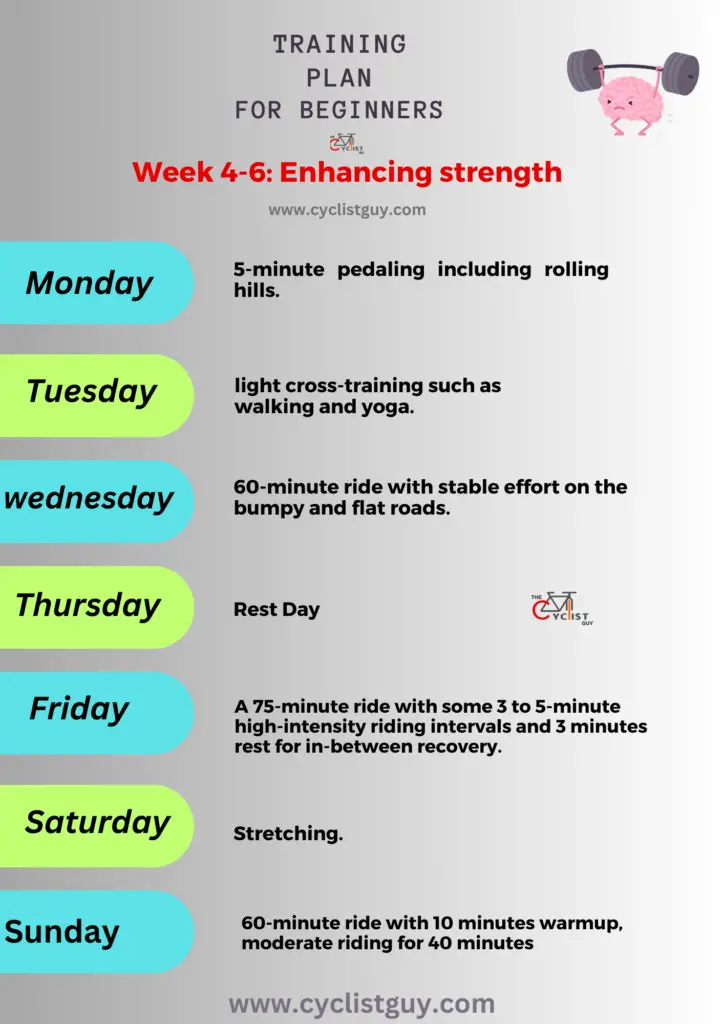
Week 7-9: Build endurance
- Monday: 60-minute ride of interval training-including 5-minute moderate intensity and 2-minute heavy intensity.
- Tuesday: Rest day.
- Wednesday: 60-minute ride on high hill mount. Keep practicing shift and pace in between mounting.
- Thursday: Light cross training-walking and stretching.
- Friday: 90-minute ride with a comfortable pace, covering long distances.
- Saturday: Rest day.
- Sunday: 90-minute ride with stable pedaling.
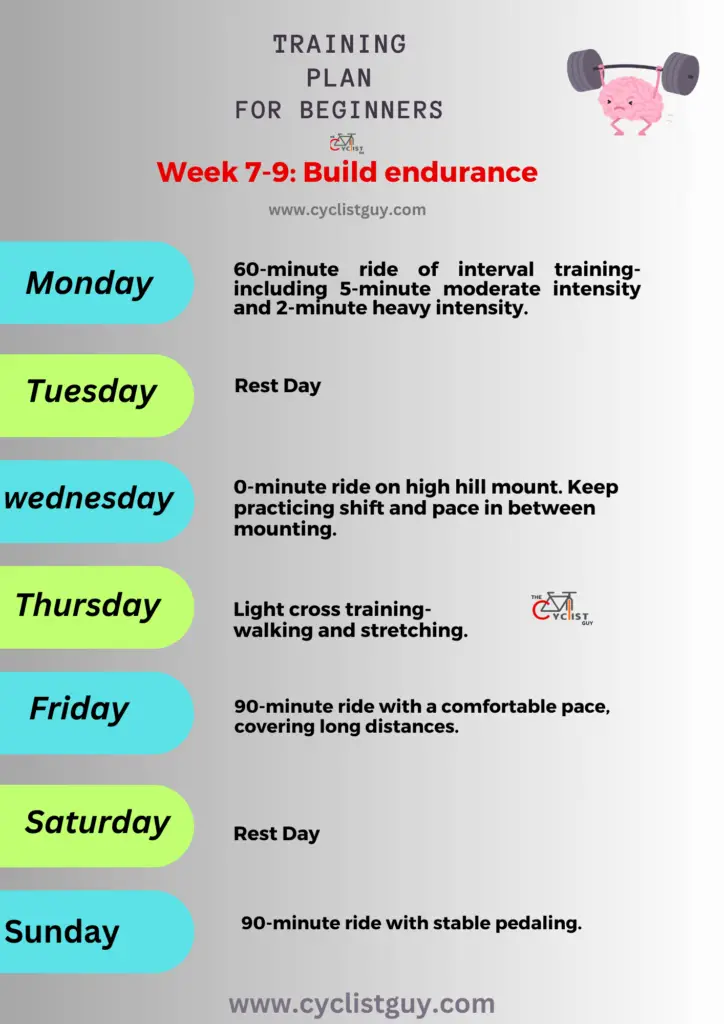
Week 10-12: Final training
- Monday: 75-minute ride with 2 to 3 interval training of 5 to 8 minutes.
- Tuesday: Stretching.
- Wednesday: 60-minute ride including several light and high-intensity interval training of 1 to 2 minutes with 3 to 4 minutes smooth pedaling.
- Thursday: Recovery day or meditation.
- Friday: 2-hour long ride at light intensity.
- Saturday: Rest day.
- Sunday: 60-minute comfortable ride with easy pedaling for recovery.
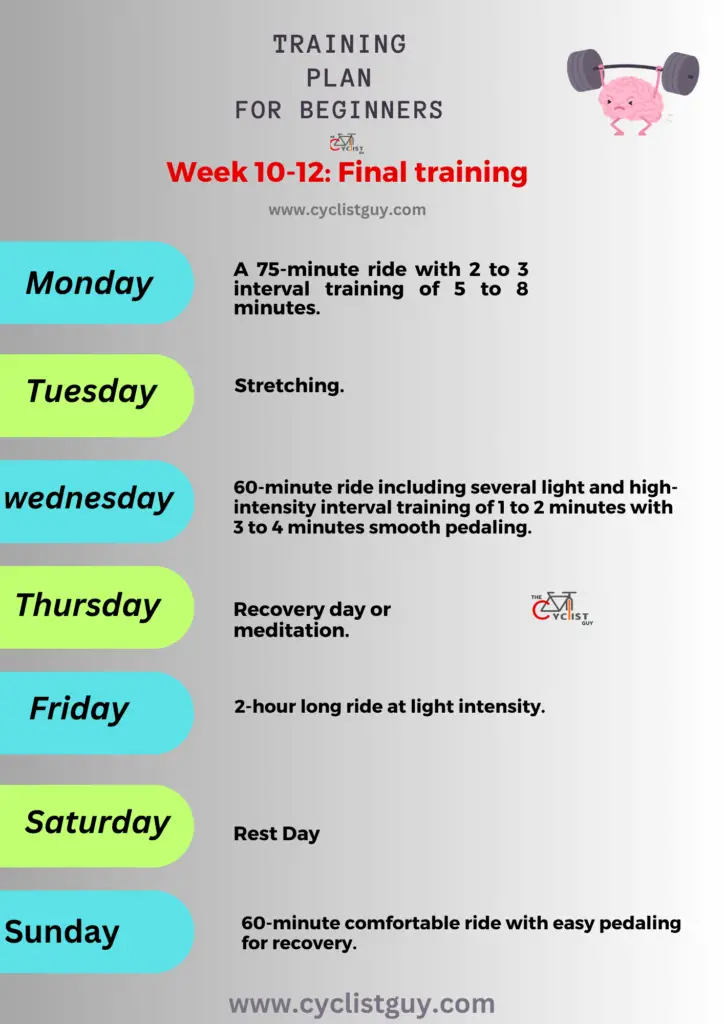
3-day-a-week Cycling Training Plan
If you don’t have enough time for a long training session, then we suggest going with a 3-day-a-week intense cycling training plan.
Though it requires more effort than the previous training schedule, it’ll be effective in emergencies.
Also, you need to prepare a balanced nutrition and hydration plan for this training session.
| Training phase | Duration | Intensity | Target | Plan |
| Day:1- Endurance phase | 90 to 120 minutes | Moderate | Increasing tolerance power and building base. | 10 minutes of light pedaling for warm-up. 70 to 100 minutes ride with consistent effort in rolling terrain and small hills. 10 minutes of slow pedaling to cool down. |
| Day:2- Interval training | 60 to 90 minutes | High | Upgrading speed and activity leve | 10 to 15 minutes of easy pedaling with 5 to 10 minutes of stretches. 5-minute intense ride with 2 minutes of slow pedaling and 1-minute intervals. 4-minute regular speed with 2-minute intense pedaling and 2-minute slow pedaling. 3-minute medium speed with 3-minute intervals and 3-minute easy pedaling. 10 to 15 minutes of a smooth ride to cool down. |
| Day:3- Boosting strength | 90 to 120 minutes | Moderate to high | Enhancing starting capacity and overall power | 10-minute warm-up pedaling with 5 to 10 minutes of dynamic leg stretches. 20 to 30 minutes of intense ride with light climbing at a steady pace to improve resistance. 10 to 15 minutes of easy pedaling to cool down. |
How to Monitor Bike Tour Training?
Only following a training plan won’t help if you don’t monitor your progress regularly. In that case, you can track the training with some easy methods.
Here are 3 effective ways to monitor your bike tour training.
- Use a smartphone tracking app or GPS watch
There are some cycling apps available for all Android and iPhone users. Go to the Play Store and install one of them.
It’ll help you track the speed, intensity level, and hill training. Also, get a GPS watch to monitor the navigation properly during rides.
- Keep a self-assessment journal
For a training journal, you can use a regular diary or digital notes. You can write down the date, time, route, distance, speed, heart rate, and temperature in your journal.
Record the weekly and monthly progress summaries and review them once a week.
- Incorporate a mentor with your training plan
Including a suitable mentor can help you to get a clear idea of your training progress with their honest opinion.
Apart from that, you can practice together and share the training plans. You can take suggestions and advice to make your training plan more effective.
Challenges of Cycling for Beginners
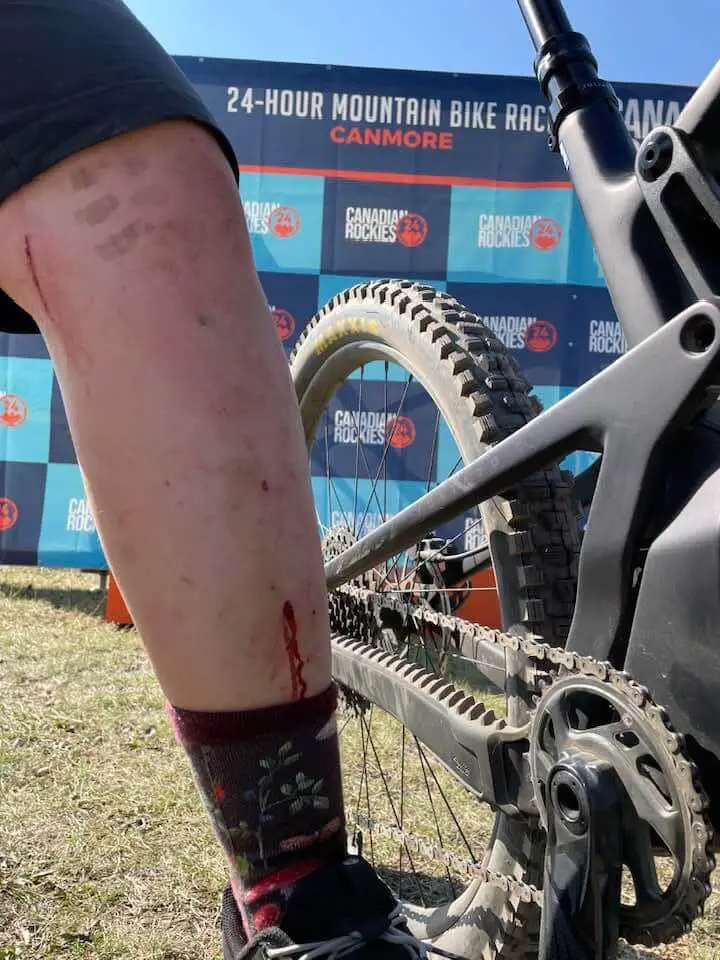
Cycling is a thrilling experience of life and there are many unavoidable challenges that riders face throughout the journey.
But once you overcome them, nothing can stop you from enjoying your frequent bike tours.
- Lack of basic cycling skills
One thing you must learn is the basic skills step-by-step.
If you don’t know the primary cycling skills like steering and handling, it’ll be difficult for you to align with the bike tour training plan.
Only knowing won’t be enough, you’ve to practice regularly.
Otherwise, it can cause severe injuries and accidents on the road. It also can make your training period harder and longer.
- Saddle discomfort
Another major problem for beginner riders is saddle discomfort issues. As you aren’t habituated to rides, it’s normal to face these challenges.
In that case, it influences your ride directly. It’s also tough to learn the saddle and seat adjustment in the beginning.
- Safety issues
According to a Breakaway Research group, 54% of American people avoid cycling due to the fear of getting hit by a car or truck.
Also, they are afraid of falling down and it makes them more conscious. It diverts their attention from the road and causes accidents.
- Weather conditions
The biggest challenge for cyclists is unkind weather conditions like rain, storms, and heavy heat. In these circumstances, it’s hard to operate the bike on the road.
Especially during rain and storms, you shouldn’t take your bike out because it’s highly risky.
- Low knowledge of traffic rules
If you understand the traffic laws, it can get you into risky situations and major legal consequences.
Moreover, it’ll make your cycling unsafe and create confusion while riding on the road.
Safety Tips to Follow During a Bike Tour
The National Highway Traffic Safety Administration states that around 846 cyclists died due to unsafe bike riding on the road.
It happens because most riders don’t have enough knowledge of cycling on the road. But you can avoid these situations if you follow some safety tips.
- Wear a high-quality helmet and reflective clothes
Most of the cyclist deaths are caused by head injuries. To get rid of this problem, you need to wear a robust and premium helmet.
While riding a bike on the road, it’s essential to make yourself visible to other pedestrians and vehicles.
That’s why you should wear reflective and vibrating color clothes, especially at night.
- Learn local traffic rules
Before going on tours, you need to research the local traffic laws of that area. It’s also applicable to the training session.
Knowing the traffic rules can save your back from legal issues and ensure a safe ride on the road.
- Ensure an organized route plan
Proper route management is necessary for the bike rides. It protects you in the unknown areas and helps you guide you on the right track.
Always keep a map of your visiting area and organize the route plan according to your convenience.
- Ride defensively
For safe cycling, you should ride carefully on the ride. However, show your hand to be visible on the road.
You shouldn’t go through blind spots and sideways to avoid collisions with pedestrians. Use headlights, mirrors, and reflective lights for better safety.
FAQs
How many km should a beginner cyclist ride?
A beginner rider should begin with short rides of 5 to 6 kilometers. It won’t be wise to ride extra kilometers quickly.
Before increasing the distance, you should build your endurance level to the highest. We recommend raising your level by 1 km a week.
Can I cycle 100 km without training?
You can but it’s not safe. Even regular cyclists train themselves before covering 100km. When it comes to long rides, you’ll need a high fitness and endurance level.
That’s not possible without proper training sessions.
How to maintain the bike while training?
After every training session, you should check tire pressure, mirrors, and lights. Also, lubricate the chain regularly during the training period.
When should a bike tour be avoided?
You should avoid the bike tour plan in heavy rain, strong winds, and thunderstorms because it can be hazardous for you and your teammates.
Additionally, you shouldn’t go on a trip if you have any severe health issues.
Bottom Line
That’s it then. Now you know everything about beginner training for a bike tour.
We’ve mentioned the benefits, training plans, requirements, safety tips, and whatnot.
If you’ve started your journey to bike riding, following our compact guide can ensure a safe and smooth tour experience.
In our opinion, starting a 12-week-based training plan is better than 3-day-a-week because this program includes all the steps that a beginner should follow.
But if you’re in a hurry, you can definitely go with the 3-day plan. Lastly, we hope choosing any of our training plans will work for you.

Hels On Wheels aka Helen Dainty is a full-time global hobo cycling around the world on a budget of AU$ 100 per week. She left the UK in 2004 and has been living out of a backpack ever since.

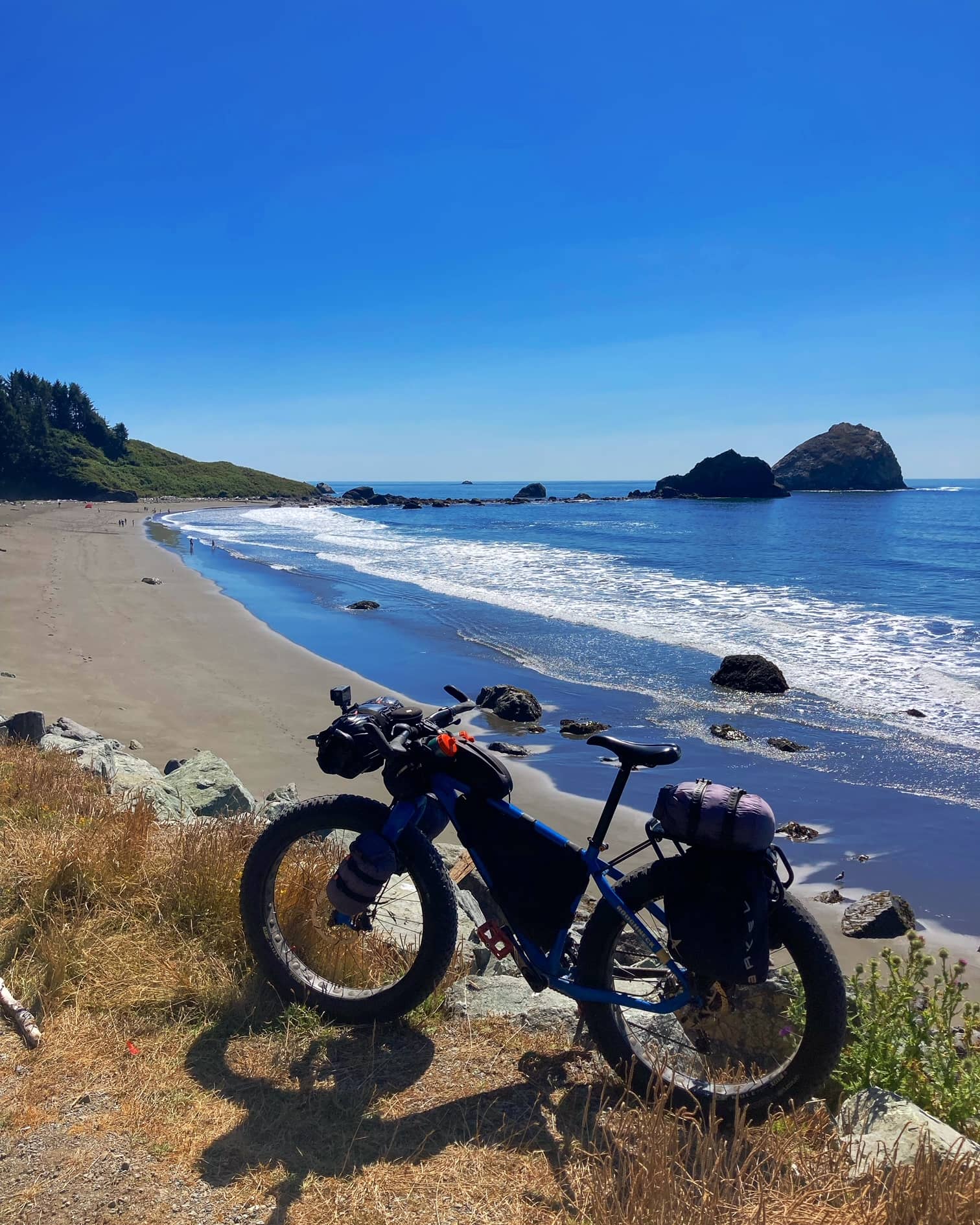
Leave a Reply